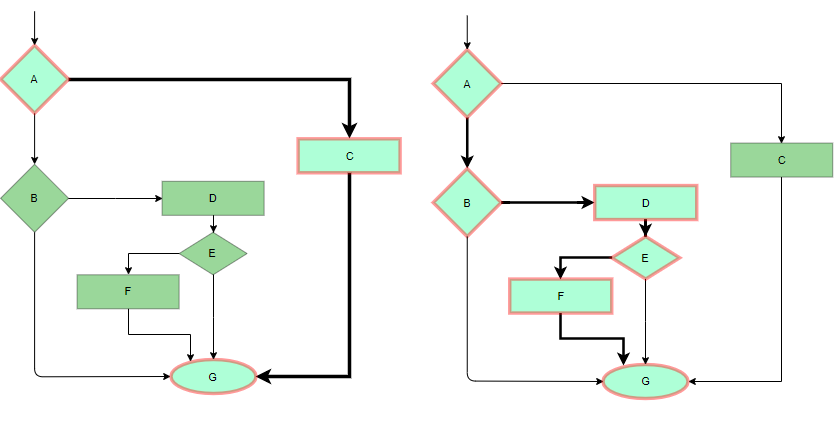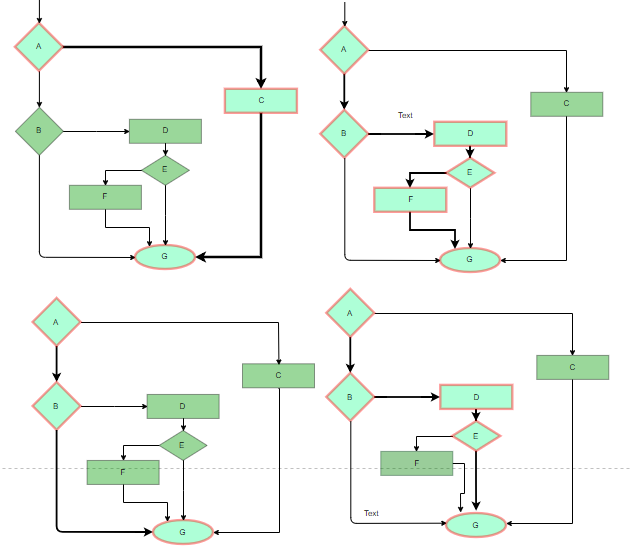White box Testing
White box testing techniques analyze the internal structures the used data structures, internal design, code structure, and the working of the software rather than just the functionality as in black box testing. It is also called glass box testing or clear box testing or structural testing. White Box Testing is also known as transparent testing, open box testing.
Generic steps of white box testing
- Design all test scenarios, test cases and prioritize them according to high priority number.
- This step involves the study of code at runtime to examine the resource utilization, not accessed areas of the code, time taken by various methods and operations and so on.
- In this step testing of internal subroutines takes place. Internal subroutines such as nonpublic methods, interfaces are able to handle all types of data appropriately or not.
- This step focuses on testing of control statements like loops and conditional statements to check the efficiency and accuracy for different data inputs.
- In the last step white box testing includes security testing to check all possible security loopholes by looking at how the code handles security.
Reasons for white box testing
- It identifies internal security holes.
- To check the way of input inside the code.
- Check the functionality of conditional loops.
- To test function, object, and statement at an individual level.
Advantages of White box testing
- White box testing optimizes code so hidden errors can be identified.
- Test cases of white box testing can be easily automated.
- This testing is more thorough than other testing approaches as it covers all code paths.
- It can be started in the SDLC phase even without GUI.
Disadvantages of White box testing
- White box testing is too much time consuming when it comes to large-scale programming applications.
- White box testing is much expensive and complex.
- It can lead to production error because it is not detailed by the developers.
- White box testing needs professional programmers who have a detailed knowledge and understanding of programming language and implementation.
Techniques Used in White Box Testing
| Data Flow Testing | Data flow testing is a group of testing strategies that examines the control flow of programs in order to explore the sequence of variables according to the sequence of events. |
| Control Flow Testing | Control flow testing determines the execution order of statements or instructions of the program through a control structure. The control structure of a program is used to develop a test case for the program. In this technique, a particular part of a large program is selected by the tester to set the testing path. Test cases represented by the control graph of the program. |
| Branch Testing | Branch coverage technique is used to cover all branches of the control flow graph. It covers all the possible outcomes (true and false) of each condition of decision point at least once. |
| Statement Testing | Statement coverage technique is used to design white box test cases. This technique involves execution of all statements of the source code at least once. It is used to calculate the total number of executed statements in the source code, out of total statements present in the source code. |
| Decision Testing | This technique reports true and false outcomes of Boolean expressions. Whenever there is a possibility of two or more outcomes from the statements like do while statement, if statement and case statement (Control flow statements), it is considered as decision point because there are two outcomes either true or false. |
Difference between white-box testing and black-box testing
Following are the significant differences between white box testing and black box testing:
| White-box testing | Black box testing |
|---|---|
| The developers can perform white box testing. | The test engineers perform the black box testing. |
| To perform WBT, we should have an understanding of the programming languages. | To perform BBT, there is no need to have an understanding of the programming languages. |
| In this, we will look into the source code and test the logic of the code. | In this, we will verify the functionality of the application based on the requirement specification. |
| In this, the developer should know about the internal design of the code. | In this, there is no need to know about the internal design of the code. |
Working process of white box testing:
- Input: Requirements, Functional specifications, design documents, source code.
- Processing: Performing risk analysis for guiding through the entire process.
- Proper test planning: Designing test cases so as to cover the entire code. Execute rinse-repeat until error-free software is reached. Also, the results are communicated.
- Output: Preparing final report of the entire testing process.
Testing techniques:
- Statement coverage: In this technique, the aim is to traverse all statement at least once. Hence, each line of code is tested. In case of a flowchart, every node must be traversed at least once. Since all lines of code are covered, helps in pointing out faulty code.

Statement Coverage Example
- Branch Coverage: In this technique, test cases are designed so that each branch from all decision points are traversed at least once. In a flowchart, all edges must be traversed at least once.

4 test cases required such that all branches of all decisions are covered, i.e, all edges of flowchart are covered
- Condition Coverage: In this technique, all individual conditions must be covered as shown in the following example:
- READ X, Y
- IF(X == 0 || Y == 0)
- PRINT ‘0’
- #TC1 – X = 0, Y = 55
- #TC2 – X = 5, Y = 0
- Multiple Condition Coverage: In this technique, all the possible combinations of the possible outcomes of conditions are tested at least once. Let’s consider the following example:
- READ X, Y
- IF(X == 0 || Y == 0)
- PRINT ‘0’
- #TC1: X = 0, Y = 0
- #TC2: X = 0, Y = 5
- #TC3: X = 55, Y = 0
- #TC4: X = 55, Y = 5
- Basis Path Testing: In this technique, control flow graphs are made from code or flowchart and then Cyclomatic complexity is calculated which defines the number of independent paths so that the minimal number of test cases can be designed for each independent path. Steps:
- Make the corresponding control flow graph
- Calculate the cyclomatic complexity
- Find the independent paths
- Design test cases corresponding to each independent path
- V(G) = P + 1, where P is the number of predicate nodes in the flow graph
- V(G) = E – N + 2, where E is the number of edges and N is the total number of nodes
- V(G) = Number of non-overlapping regions in the graph
- #P1: 1 – 2 – 4 – 7 – 8
- #P2: 1 – 2 – 3 – 5 – 7 – 8
- #P3: 1 – 2 – 3 – 6 – 7 – 8
- #P4: 1 – 2 – 4 – 7 – 1 – . . . – 7 – 8
- Loop Testing: Loops are widely used and these are fundamental to many algorithms hence, their testing is very important. Errors often occur at the beginnings and ends of loops.
- Simple loops: For simple loops of size n, test cases are designed that:
- Skip the loop entirely
- Only one pass through the loop
- 2 passes
- m passes, where m < n
- n-1 ans n+1 passes
- Nested loops: For nested loops, all the loops are set to their minimum count and we start from the innermost loop. Simple loop tests are conducted for the innermost loop and this is worked outwards till all the loops have been tested.
- Concatenated loops: Independent loops, one after another. Simple loop tests are applied for each. If they’re not independent, treat them like nesting.
- Simple loops: For simple loops of size n, test cases are designed that:
White Testing is Performed in 2 Steps:
1. Tester should understand the code well
2. Tester should write some code for test Cases and execute them
Tools required for White box Testing:
- PyUnit
- Sqlmap
- Nmap
- Parasoft Jtest
- Nunit
- VeraUnit
- CppUnit
Advantages:
- White box testing is very thorough as the entire code and structures are tested.
- It results in the optimization of code removing error and helps in removing extra lines of code.
- It can start at an earlier stage as it doesn’t require any interface as in case of black box testing.
- Easy to automate.
- White box testing can be easily started in Software Development Life Cycle.
- Easy Code Optimization.
Disadvantages:
- Main disadvantage is that it is very expensive.
- Redesign of code and rewriting code needs test cases to be written again.
- Testers are required to have in-depth knowledge of the code and programming language as opposed to black box testing.
- Missing functionalities cannot be detected as the code that exists is tested.
- Very complex and at times not realistic.
- Much more chances of Errors in production.